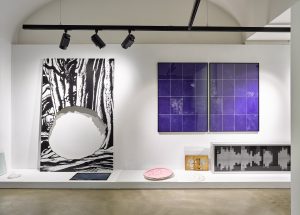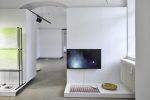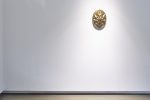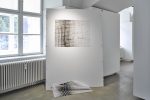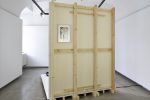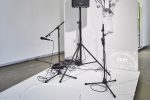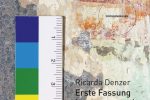Erste Fassung (Interpretation)
Ricarda Denzer
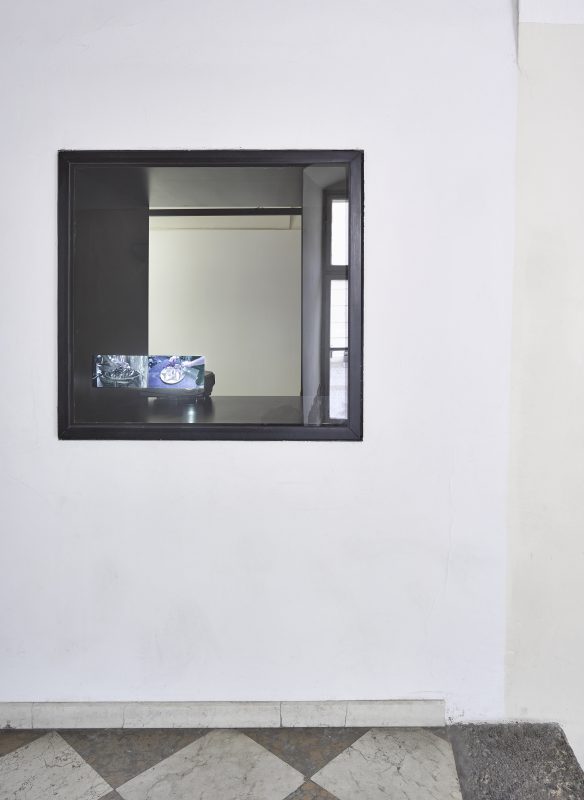
First Version (Interpretation)
Ricarda Denzer
In her transmedia works Ricarda Denzer sounds out the limits of video and media art. The focus is directed towards investigation of open forms, towards an acoustic and filmic way of thinking, and performative phenomena like the voice, the spoken word, forms of narrative, and language as such.
Denzer thematizes the capacity to act, on the threshold of fact and fiction, in sociopolitical and artistic processes in her works. The starting points are often listening, speech, and the telling of stories. Subsequently, Denzer combines video, text, photos, audio plays, drawings, objects and spatial installation in audiovisual research spaces, creating a complex and self-reflective artistic position, via which she sets herself in relation to places, people and the times in which we live.
In her current series, the artist devotes her attention to the production, and simultaneously to the disintegration of a work. As in archaeology, the “missing parts” of a found object are interpreted during the restoration and either completed using new material or left as empty spaces. The “dirtying” of the cast form of an historical object with the original earth from the site where it was found in order to make the copy look more realistic – a method used by archaeologists – is interpreted by Denzer in various respects. Here, the original stands for the source, for the documentation, and the origins. In the artistic process, therefore, there is fluid movement between the finding of an object, the documentary moment, and the deviation from the original, that is, towards re-assembly in the production of fiction and narrative using the technique of montage.
On a central axis in the entrance area to the gallery, on an area of wall with a projecting platform, we find research materials, objects and works arranged in accordance with the production process of her work, in the pattern of language itself – as alternating modulation, breath, rhythm, voice, hesitancy, and pauses. Movement becomes visible in space. Another aspect is the physical presence of the body, as well as traces of its absence – printed, molded, rubbed, beaten out, hammered, and drawn.
The unearthing of layers is realized in debate with places, materiality, narratives, and the voice itself. The excavation of ochre pigments or iron ore in mines below an historical area of woodland in England, pictorial materials with biographical references or blueprints are adopted as stimuli and arranged without directly naming the locations. This is also true of the central object in the exhibition, an iconoclastic, star-shaped “Bronze Mask”, which stands equally for both interpretation and imagination. The concentrated display clarifies Denzer’s artistic method.
The artist always works in a site-specific way as well, and she uses parts of the wooden wall planking as a production space for the exhibition in the Neue Galerie: on the one hand, as an actual stage with loudspeaker box and microphones to record discussion held as dialogue; elsewhere as a display for pictorial works. In turn, the historical murals behind the planking walls of the gallery appear in the form of a pictorial motif, which was borrowed by the artist – like the title of the exhibition – from the documentary findings of the Neue Galerie’s restoration team. In First Version (Interpretation) Ricarda Denzer plays with an open form of narrative, whereby the narrative threads are precisely positioned, certainly, but not conceived in a linear but a spatial, three-dimensional way.
The presence of various places, bodies and voices is suggested by objects, sound and fragments and then set into multiple diverse relations. Ricarda Denzer’s First Version (Interpretation) allows space, as a model of thought behind a multiperspective narrative, for interpretations which will lead to an audio work in a next version.
Cornelia Reinisch-Hofmann
————————–
Echo, or Deviation from the Original
First Version (Interpretation)
I crawl into the next deepest mine through openings just big enough for my body. My helmet lamp scans the crusted rock walls along the dark tunnels. In the silence I hear the blood rushing in my head. From the iron and ochre mines underneath the Forest of Dean, on the Welsh border in Gloucestershire, I now move to the dome of Hagia Sophia in Istanbul, to the choirs of the Seraphim angels, who fly around the firmament to God with their six wings, burning and singing. Holy, holy, holy.
The face of the angel, consisting only of feathers and wings, was not uncovered until after restoration work on the building, and only reconstructed a few years ago. When the Byzantine basilica was converted into a mosque, the faces were covered with a star-embossed brass mask in accordance with the Muslim faith. This oval object attracted my attention. It makes characters in a science fiction scene of them. The regularity of the shape, the perfection of the shiny brass structure of the star on the colourful, soft-looking angel’s feathers evokes a futuristic image. I remember the sound, the physical sensation, my own sensual experience inside the Hagia Sophia.
Sky, clouds and treetops are reflected in the ochre-coloured surface of a pool of water. It is said that the industrial age started here, in these mines. Iron ore is produced by the flow of water that has smoothed its way through the shale over time. In contrast to coal, which is stripped horizontally in layers, the iron is extracted in a flowing process.
In a radio interview, Kari Polanyi talks about her father, the economist Karl Polanyi who wrote “The Great Transformation” in the 1940s, where he referred to the time of the Industrial Revolution in England as at the root if we are to understand fascism in Europe, Germany and Austria. The beginning of industrialisation and individualisation accompanied by the uncontrolled system of the free-market economy.
I film the studio of the sculptors Dorota Ropac and her husband Antoni, in a former church in the Forest of Dean, where numerous bronze sculptures, portraits, busts and reliefs stand. A huge enlarging pointer for making large sculptures fascinates me. A tool from another century, that’s also how the atmosphere of the studio itself affects me. The life-sized sculpture of a mineworker stands side by side with busts of Mrs. Thatcher.
During the making of the bronze star I learned a lot about the working process and the material from the Polish artist — although I still had images of the craftsman in his small workshop in Istanbul in my mind, driving and hammering the star shape into the brass sheet above a bed of thick black asphalt with a lot of fire and heat.
The ochre colours that were mined alongside the iron and coal here in the mines of the Forest were evident in the frescoes of the Sistine Chapel. “Colour has to do with voice” and “speech is not voice”, to use a quotation.
Whenever it rains, red from the ferrous rock seeps up to the surface of the forest and colours the puddles and paths red. A fairytale forest where the trees are slightly smaller due to the nature of the slate soil. Of course, I also grew up with pictures of the forest from the fairytales of the brothers Grimm. Even in Ancient Greek and Roman times there was the idea that trees were animated and acted like living beings. The roots already start above the ground, and one can imagine how they continue their way below. Apparently, J. R. R. Tolkien spent time here and was inspired by this forest for his later books and the mythical world of Middle Earth.
I heard about the Freeminers on my first visit to the Forest of Dean. I found out that there is a Speech House in the forest, something like a forest parliament.
In the Middle Ages, the king granted the miners in the Forest of Dean certain mining rights. If they had worked in the forest for a year and a day, were over 21 years old and male and were born and lived within the Harde of St. Briavels, where the king kept a hundred soldiers, then they were entitled to become Freeminers. Freelance miners. That sounds like a freelance artist to me. A contradiction in terms, as the English miners are famous for their trade union organisation and their struggle for workers’ rights.
And now there is the first woman who fought for the title of Freeminer: Elaine Morman is ready to give me an interview. She stands completely at one with her surroundings, and I have the symbol of her guild, the helmet with the lamp, before me. The greens of her clothes almost like camouflage in the forest surrounding her.
“Hello, my name is Elaine Morman. I am the only woman Freeminer who works in the Forest of Dean. This here is the Secret Forest, where part of the old iron ore mines are found still remaining in the Forest of Dean at the moment. Most of them have gone now.
When I tested the waters, probably about seven years ago, and applied to become a Freeminer, I was turned down straight away. But because the Act did not actually ban women from becoming Freeminers, eventually they awarded me the certificate. Since then, I’ve been the only freelance woman mineworker. Nobody has objected yet. I’ve always wanted to be a Freeminer, although I always used to presume I couldn’t apply as a woman. When I turned 50 I thought I’d test the waters to see if it would be possible. It was a struggle because I was turned away several times, but I kept asking and eventually succeeded.”
Looking online, I find one of Alexander Kluge’s interviews with the cultural historian Hans Belting about his book Faces. There, I hear that an Arab scholar talks about how images, figurative illustrations, only exist in the mind. So there are images in the Muslim philosophy of science, but they are internal images. A fine example of a misunderstanding in cultural transfer. According to Belting, cultural understanding takes the place of reception here.
In Making Face, Making Soul Gloria Anzaldúa writes about a metaphor for the construction of identity: “We rip out the stitches, expose the multilayered ‘inner faces’, attempting to confront and oust the internalized oppression embedded in them, and remake anew both inner and outer faces”…I imagine the tinny sound of the Seraphim’s voice behind the brass mask. Like a radio studio sound effect, creating a particular sound for an audio play. Holy, holy, holy.
The star-shaped object not only covered up the individual image of the angel, but also reproduces and fragments the imaginary opposite in the reflecting facets of the surface. I currently interpret it as an invitation to the imagination of the viewers of our culture of light and sight shaped by the Enlightenment, offering a multiple perspective. As long as the mask is placed in front of the angel’s face, there is no looking back at what is happening down there. From the angel’s point of view, therefore, imagination in concave.
The miners held a candle in a forked twig with a piece of clay, as a pit light that they held in their mouths. Then they had to talk to each other with this twig in their mouths. They held the candle with their mouths to keep both hands free without obstructed their view. That they had to speak with a twig in their mouths is perhaps the reason why the English has its own accent in the Forest. The candle-holders and candles were called “Nellies”. So the people were also popularly called Nellies.
Like an archaeologist, I interpret missing parts of a find during restoration and will either add material as a filler or leave gaps.
I note: conservation as a “critical act”, conservators, shadow fabricators, perspectives on the substance of the material and the meaning, multiple authorship, responsibility, transience, fluidity and the fleeting as a framework for the search for orientation through material. Dog-ears at every corner. Directionless searching. Voice and gaze create closeness and distance. Sequence, frequency. Speaking fully, empty words, touching words. Spreading out like sound. Being here and there at the same time, like the voice.
I interpret the ‘dirtying’ of the cast of a historical object with original soil from the site, a method used by Innsbruck archaeologists to make a copy look more real, and as a way of engaging with the original, its origin, the document and the source. An option for a fluid artistic process to present the movement between the finding of an object, the documentary moment, the facts and its re-assembly, and the production of the fiction through montage.
I hear the sound of the place of origin in the language of those speaking, I hear and note: rhythm, faltering, pauses, colouring, the surrounding space and the body in the voice. By ‘listening to thinking’ I transfer my body to the paper until the colour fades away. I associate words that describe the state of the material during restoration with the Lexicon of the Mouth, where Brandon LaBelle summarises everything that the mouth produces as a “tool”.
What do I bring with me, what do I find already there? As a plane concealed behind a protruding, floating gypsum plasterboard wall with a wooden substructure, behind many layers of grey and white lime and of tempera, are murals on the Baroque walls, a classicist version around 1800 and a second, Biedermeier version, documented by the restorers.
I transfer my studio wall as a model, as a basis, an idea or guide. Wall rubbings. Blueprint, a frequently used metaphor in the media.
In my work, rendering traces and imprints visible, and revealing layers by engaging with the locations, with the materials, with the narrative, lead right down to the voice itself. The exploration of the nature of original materials, the recently supplemented, reconstructed material, but also the technique of leaving gaps between pieces of original finds and the interpretation of missing pieces in the restoration process serves, for me, as a conceptual basis or a figure of speech.
On the television programme Voices, John Berger and Susan Sontag talk about storytelling. Berger generates his story from real events and sees images while writing. Sontag understands writing as an art form detached from real events, and she hears voices while writing. I decide to place this dialogue in the space as an abstract sound diagram, and allude to my idea of the simultaneity of both possibilities in a narrative.
Before the glasses are wrapped in newspaper for the packing case, I drive my ink-smeared fingers along the glass edges and make them resound, The Inner Acoustic.
Echo, or the deviation from the original. When I create a work, I am already engaging with its decay.
Ricarda Denzer
Long Night of Museums on Saturday, 6th October 2018, from 6 pm to 1 am: dialogue tour at 8 pm
Premiere Days 2018 on Saturday, 10th November 2018:
Finissage from 11 am – 5 pm
Denzer – Dlobies Artist-Artist Talk in the Neue Galerie at 3 pm
Seibold – Rezned Artist-Artist Talk in the Kunstpavillon around 4 pm
(www.premierentage.at)
